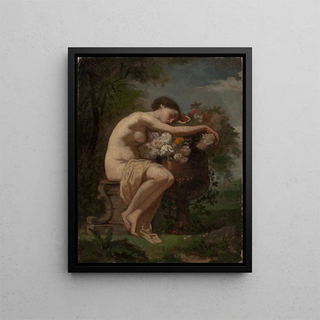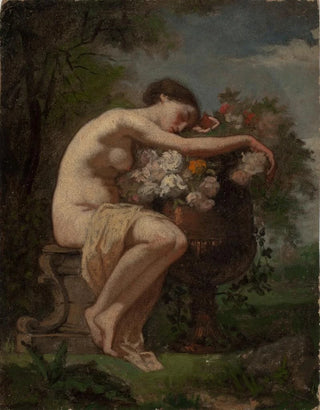Art print Study of a nymph next to a flower urn - August Jernberg | Art print


View from behind

Frame (optional)
Study of a Nymph beside a Flower Urn - August Jernberg – Captivating Introduction
The artwork "Study of a Nymph beside a Flower Urn" by August Jernberg embodies a delicacy and poetry that transport the viewer into a universe where natural beauty and art harmoniously converge. This piece, both classical and evocative, highlights the artist's skill in capturing the fragility and elegance of femininity. The nymph, a mythological figure often associated with nature and sensuality, stands gracefully beside an urn adorned with flowers, symbolizing fleeting life and beauty. This painting invites deep contemplation, where every detail—from the delicate curves of the silhouette to the vibrant colors of the flowers—elicits silent admiration.
Style and uniqueness of the work
August Jernberg's style is distinguished by a subtle combination of realism and romanticism. In this artwork, the artist's technique is revealed through meticulous brushstrokes and a keen attention to detail. Light plays a crucial role, illuminating the nymph in an almost supernatural way, while the richly decorated flower urn adds an extra dimension to the composition. The chosen colors, both soft and vibrant, evoke a serene atmosphere, conducive to escape and daydreaming. Jernberg manages to create an intimate and personal ambiance, where the observer feels invited to share a privileged moment with the nymph. This painting stands out not only for its technique but also for its message, celebrating beauty and nature while prompting reflection on the relationship between humans and the natural world.
The artist and his influence
August Jernberg, born in Sweden in the 19th century, established himself as a renowned artist, influenced by the artistic movements of his time. Trained at the Royal Swedish Academy of Arts in Stockholm, he developed a unique style blending realism and symbolic elements. Jernberg was particularly inspired by mythology and nature, themes that are reflected throughout his work.

Matte finish

View from behind

Frame (optional)
Study of a Nymph beside a Flower Urn - August Jernberg – Captivating Introduction
The artwork "Study of a Nymph beside a Flower Urn" by August Jernberg embodies a delicacy and poetry that transport the viewer into a universe where natural beauty and art harmoniously converge. This piece, both classical and evocative, highlights the artist's skill in capturing the fragility and elegance of femininity. The nymph, a mythological figure often associated with nature and sensuality, stands gracefully beside an urn adorned with flowers, symbolizing fleeting life and beauty. This painting invites deep contemplation, where every detail—from the delicate curves of the silhouette to the vibrant colors of the flowers—elicits silent admiration.
Style and uniqueness of the work
August Jernberg's style is distinguished by a subtle combination of realism and romanticism. In this artwork, the artist's technique is revealed through meticulous brushstrokes and a keen attention to detail. Light plays a crucial role, illuminating the nymph in an almost supernatural way, while the richly decorated flower urn adds an extra dimension to the composition. The chosen colors, both soft and vibrant, evoke a serene atmosphere, conducive to escape and daydreaming. Jernberg manages to create an intimate and personal ambiance, where the observer feels invited to share a privileged moment with the nymph. This painting stands out not only for its technique but also for its message, celebrating beauty and nature while prompting reflection on the relationship between humans and the natural world.
The artist and his influence
August Jernberg, born in Sweden in the 19th century, established himself as a renowned artist, influenced by the artistic movements of his time. Trained at the Royal Swedish Academy of Arts in Stockholm, he developed a unique style blending realism and symbolic elements. Jernberg was particularly inspired by mythology and nature, themes that are reflected throughout his work.
12,34 €






